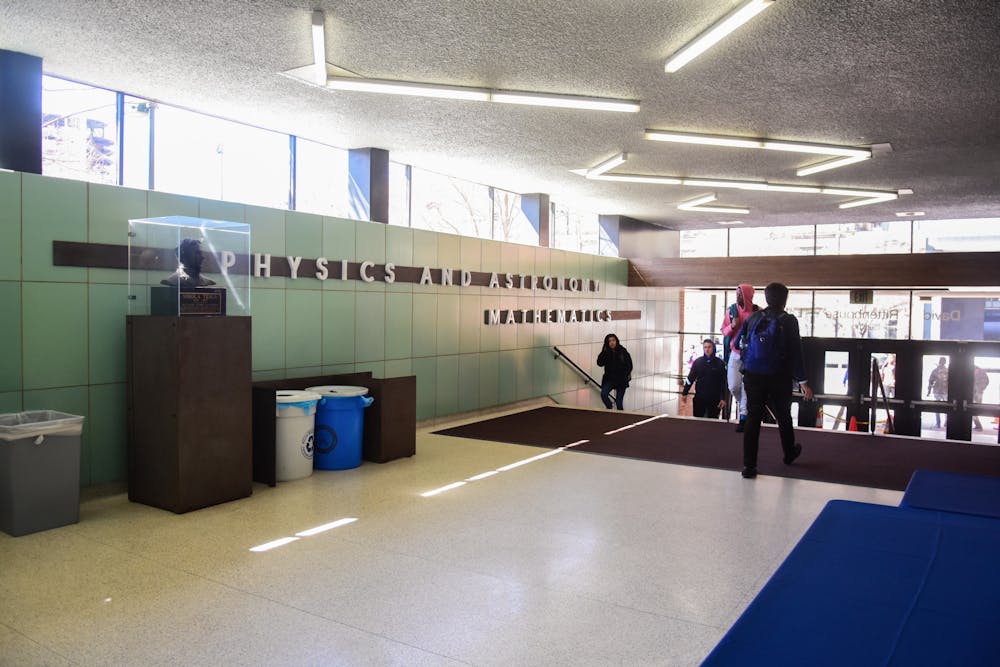
Penn's Physics and Astronomy Department received $4 million to recruit a team of students and postdoctoral fellows to analyze images from NASA's Roman Space Telescope.
Credit: Annie LuoPenn researchers are collaborating with NASA to develop the Nancy Grace Roman Space Telescope, which aims to bring insight into dark energy and planets outside the solar system.
The NASA-led Roman Space Telescope, which has been in development for over a decade, is set to launch by May 2027. A team of four researchers in Penn's Physics and Astronomy Department received four million dollars in funding to bring students and postdoctoral fellows onto the project, forming a university group to analyze the telescope's images.
The Roman telescope is built from equipment originally used for spy satellites owned by the National Reconnaissance Office. The primary mirror will provide a field of view at least 100 times wider than the Hubble Space Telescope, according to NASA.
Arifa Hasan Ahmad and Nada Al Shoaibi Presidential Professor of Physics and Astronomy Masao Sako will focus on observing and identifying supernovae based on the Roman's observations. In fall 2024, first-year and second-year graduate students in Sako’s lab will be joining the project under his supervision. Other Penn researchers on the project include Walter H. and Leonore C. Annenberg Professor in the Natural Sciences Bhuvnesh Jain, assistant physics and astronomy professor Robyn Sanderson, and research scientist Michael Jarvis.
College junior Joy Gong joined Sako’s lab through the Penn Undergraduate Research Mentorship Program the summer after her first year, which is when she first became involved with Roman. She said that she has always wanted to be involved in the field of astrophysics and wanted to learn more about what the field entails.
“I had no clue what actual astrophysics work looked like, so it was really interesting," Gong said.
Gong said that Sako prioritizes "mentorship over productivity," highlighting his focus on ensuring that students who join the project gain research experience.
"As a mentor, he makes sure people aren’t overwhelmed,” Gong said. “With my classes, it can be difficult to manage. But I think he’s really great at responding to my needs and concerns as a researcher.”
Fifth-year PhD student Helen Qu, who works on data and machine learning research, is developing Roman's capability to recognize different spots of light as different celestial bodies, such as galaxies, stars, or planets. She said that she has been able to integrate knowledge from her undergraduate degree in computer science, as well as other projects she is currently working on.
“We have tons and tons of data coming in from telescopes such as Roman," Qu said. "So it’s basically applying skills that I have, but towards something that has a lot of really cool scientific impact."
Roman is named for the “Mother of Hubble,” Nancy Grace Roman, who pushed for developments in new tools that would enable NASA scientists to explore the farther reaches of the universe, eventually leading to the launch of the Hubble Space Telescope.
The project as a whole has entered a new stage. NASA engineers are currently working on physically constructing Roman, which additionally requires significant software engineering and data analysis.
Sako said that while there are more official scientific decisions to be made regarding Roman, he is excited to mentor and work with a diverse group of "younger scientists."
“It's important to train younger students so that in ten years, they can become they can become the next leaders,” Sako said. “I’m really excited to work with students and that this project is moving forward.”
The Daily Pennsylvanian is an independent, student-run newspaper. Please consider making a donation to support the coverage that shapes the University. Your generosity ensures a future of strong journalism at Penn.
Donate






